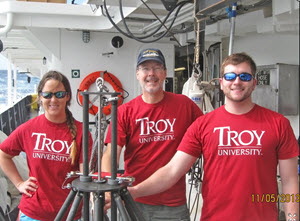
Ceil Martinec, Stephen Landers, and Craig Schimmer pose with the multicorer they use to retrieve sediment samples from the Gulf. (Photo courtesy of Stephen Landers)
Ceil Martinec picks microscopic creatures out of mud collected from deep in the Gulf of Mexico. She is looking for possible lingering effects of the 2010 oil spill on sediment-dwelling animals and making some exciting discoveries along the way.
“We are documenting new species for the area and studying the natural links or relationships between new and known organisms and their surrounding environment,” she explained.
Ceil recently earned her master’s degree in Environmental Science at Troy University and completed her thesis as a GoMRI Scholar. She was a research team member on the project Analysis of Continental Shelf Meiofauna in the Northern Gulf of Mexico: Effects of the Deepwater Horizon Oil Spill Investigated during a Long Term Community Study. Ceil shared her journey from the heart of Texas to the Gulf’s deep waters.
Her Path
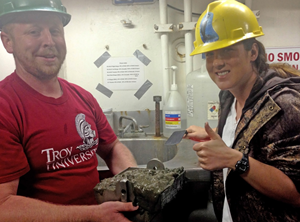
Ceil and lab mate Jonathan Miller display the sediment they collected for their meiofauna research. (Photo courtesy of Ceil Martinec)
Ceil grew up landlocked in Fort Worth, Texas, but she always found the ocean fascinating. Her father worked as an offshore welder, and the tales of his experiences at sea fueled her interest.
She accepted a soccer scholarship to Troy University in 2007. As a member of the athletic program’s leadership council, Ceil participated in community service and fundraising events and volunteered as a local high school soccer coach, all while earning top grades academically. There she met Dr. Stephen Landers, Professor of Biological and Environmental Sciences, who was impressed with her work ethic and influenced her decision to major in marine biology.
Ceil completed her undergraduate studies, then worked for two years as a NOAA fisheries observer. She boarded commercial fishing vessels in the Gulf and Atlantic Ocean, collecting data on fishing gear, catch and discard rates, target and non-target species, and interactions with marine mammals and sea turtles. She also educated fishermen on regulations and handling protected species. Landers, who regularly collaborates with NOAA, contacted Ceil in 2013 and asked if she would consider graduate school and assist him with his GoMRI-funded oil spill research.
Her Work
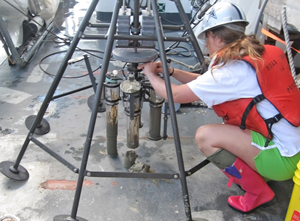
Ceil takes sediment samples from a multicorer during a NOAA cruise in November 2013. (Photo credit: Stephen Landers)
Ceil and the Landers’ team are studying meiofauna in the northern Gulf of Mexico continental shelf. They are documenting species’ abundance, checking to see if they have increased or diminished after the spill, which could provide useful information when assessing future events. Their study could also reveal previously unknown details about meiofaunal populations in the Gulf of Mexico.
Ceil joined the annual NOAA fall fish survey cruises in 2013 and 2014, collecting sediment samples on the research vessels Pisces and Gordon Gunter. These extensive field expeditions lasted over two weeks, sampling areas from Texas to south Florida across the continental shelf.
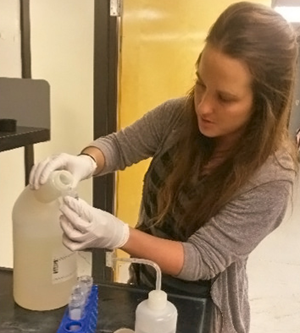
Ceil extracts meiofauna for closer inspection. (Photo credit: Kesley Gibson)
Painstaking lab work followed, with each sample taking up to ten hours to process. Ceil sorted the samples using a centrifuge to separate the meiofauna from the sediments. Then she isolated animals and documented densities. She counted the meiofauna under a microscope, classifying them where she could and sending the others to experts to identify. The team has described entirely new species of meiofauna in a group known as mud dragons.
Ceil processed, analyzed, and reported on the resultant data sets. She and others on their team have been writing manuscripts about their findings, including one paper on which she was the lead author: International Journal of Oceanography Sediment chemistry and meiofauna from the Northern Gulf of Mexico continental shelf.
Her Learning
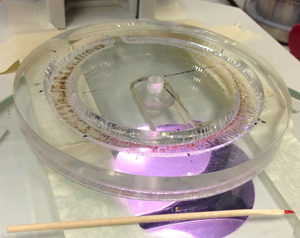
Ceil uses a counting wheel under a microscope to count and sort the meiofauna. (Photo credit: Ceil Martinec)
Ceil credits Landers for his guidance through the world of research science.
“I have learned that although the scientific process can be tedious at times, it is very rewarding,” she said, adding that “constructive criticism from the people around you and the peer review process is very important in order to make your work better.”
Ceil presented her research at Gulf of Mexico Oil Spill and Ecosystem Science conferences in Mobile and Houston. Her presentation in Houston was about the marine nematode communities they collected from central Louisiana to Apalachicola, Florida at 49-316 meters depth. “It was exciting to join the larger GoMRI community,” she said. “Those experiences showed me the importance of networking and collaboration among fellow scientists.”
Her Future
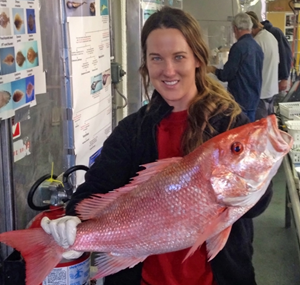
Ceil joined the annual NOAA Fish Survey cruise, identifying species like this red snapper. (Photo courtesy of Ceil Martinec)
Ceil graduated with her masters in May and married in September. She hopes to pursue a career in fisheries biology, ideally with the Alabama Marine Resources Division, focusing on either recreational or commercial fisheries. She also is considering fishery biologist positions with the State of Florida Fish and Wildlife Service and NOAA and environmental science openings in government, industry, or environmental consulting agencies.
Ceil plans to volunteer until the right position comes available. “Right now,” she said, “any experience I can get will be helpful in building my future career.”
Praise for Ceil
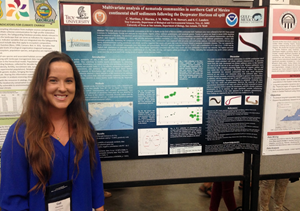
Ceil presents her findings at the Gulf of Mexico Oil Spill and Ecosystem Science conference in Houston. (Photo credit: Jonathan Miller)
Landers described Ceil as an excellent student, saying, “She tackled multivariate statistics and impressed me with how fast she absorbed its complexities.”
Ceil did not engage in lengthy field work as an undergraduate, but Landers felt that she was the right fit for the graduate-level position in his GoMRI project, and she did not disappoint him. “She worked very hard and was very involved in sample collections on the NOAA ships as well as in the lab,” Landers recalled. “She leaves Troy with one paper already published and another one in the works,” Landers said. “I’m sure she’ll be a very successful scientist.”
Ceil received the Troy University 2015 Best Graduate Research Scholar Award.
The GoMRI community embraces bright and dedicated students like Ceil Martinec and their important contributions. The GoMRI Scholars Program recognizes graduate students whose work focuses on GoMRI-funded projects and builds community for the next generation of ocean science professionals.
Learn more about this research at Landers’ website.
This research was made possible in part by a grant from BP/The Gulf of Mexico Research Initiative (GoMRI) to Troy University for the project Analysis of Continental Shelf Meiofauna in the Northern Gulf of Mexico: Effects of the Deepwater Horizon Oil Spill Investigated during a Long Term Community Study.
The GoMRI is a 10-year independent research program established to study the effect, and the potential associated impact, of hydrocarbon releases on the environment and public health, as well as to develop improved spill mitigation, oil detection, characterization and remediation technologies. An independent and academic 20-member Research Board makes the funding and research direction decisions to ensure the intellectual quality, effectiveness and academic independence of the GoMRI research. All research data, findings and publications will be made publicly available. The program was established through a $500 million financial commitment from BP. For more information, visit http://gulfresearchinitiative.org/.
